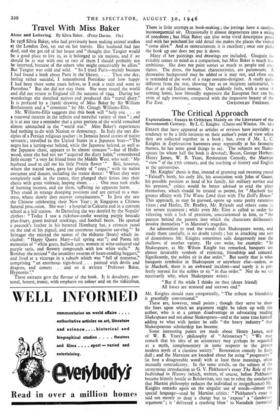Travel With Miss Baker
Alone and Loitering. By Silvia Baker. (Peter Davies. 15s.)
IN 1938 Silvia Baker, who had previously been making animal studies at the London Zoo, set out on her travels. Her husband had just died, and she got rid of her house and "thought that Tangier would be a good place to live in, as it belonged to six nations, and if we should be at war with one or two of them I should probably not be interned, because of the others who might conceivably be allies." But Tangier was cold and wild. "So I tried Paris—mainly because I had found a book about Paris in thelibrary. . . Then one day, feeling rather suicidal, I remembered Portofino and how happy I had been there some years before, so I took a train and went ta Portofino." But she did not stay there. She went round the world and did not return to England till the autumn of 1944. During her wanderings she sketched natives and produced this "travel diary." It is prefaced by a (1916) drawing of Miss Baker by Sir William Rothenstein and a " comment " by Mr. Clough Williams-Ellis.
Mr. Williams-Ellis suggests that this book will "help you . . . to a renewed interest in the infinite and merciful variety of man" ; and it is at any rate a reminder that a great portion of the world remained almost untouched in the "world war.' Miss Baker's experiences had nothing to do with Nazism or democracy. In Italy she met dis- ciples of a Persian religious teacher ; in Jamaica heard stories of native servants ; travelled to the United States in a Japanese boat—" The negro has a jutting-out behind, while the Japanese behind, as well as the Japanese chest, appears to be almost concave "—but of Holly- wood, since she had not yet "acquired the diary habit," remembered little except "a very fat friend from the Middle West, who said : My husband used to call me his little Prairie flower '." Bali, however, where she stayed next, gave her plenty of "copy," with its native costumes and dances, including the trance dance : When they were completely sunk in the trance, they plunged their krises into their chests with great violence, leaping about. . . . One man took sticks of burning incense, and ate them, 'suffering no apparent harm. . . They stand in strange drooping positions and are carried to a mat- tress where slowly they recover consciousness." In Java she saw
the mat- tress, celebrating their New Year ; in Singapore a Chinese
funeral proczssion. She was i • a hospital in Calcutta and in a convent school at a hill station. At Darjeeling she. was dazzled by the Nepalis' clothes : "Today I saw a rickshaw-coolie wearing purple brocade plus-fours, green knitted stockings, and football boots. He sported a peacock's feather in 'his battered Homburg hat, a crimson tassel on the end of his pigtail, and one enormous turquoise ear-ring." In Srinagar she enjoyed the names of the shikaras (boats) which in- cluded: "Happy Queen Mary—full spring seat "; and Poona left memories of "white goats, bullock carts, women in wine-coloured and purple saris, and flowery compounds with low white walls." At Bombay she noticed "the countless swarms of heart-rending beggars'," and lived at a vicarage in a suburb which was "full of nonsense," comprising "an enormous sign-board . . . painted with devils and dragons, and comets . . and on it written 'Professor Bakst, Hypnotits '."
These extracts give the flavour of the book. It is desultory, per- sonal, honest, ironic, with emphasis on colour and on the ridiculous. There is little attempt hat book-making the jottings have a careless inconsequential air. Occasionally it ahriost degenerates into a string of anecdotes ; but Miss Baker can also write vivid descriptive prose and with her penchant for odd detail she snakes the places 'she visited "come alive." And as entertainment it is excellent ; once one picks the book up one does not put it down.
Many of her paintings and drawings are included. Gauguin in- evitably comes to mind as a comparison, but Miss Baker is much le.,s ambitious. She does not paint scenes so much as people and cos- Mmes. The dress, the human characteristics, are paramount. A decorative background may be added or .it may not, and often one is reminded of the work of a stage costume-designer. A study quite different from the rest, showing her as an incipient caricaturist, is that of an old Italian woman. One suddenly. feels, with a sense 3f coming home, how blessedly expressive the European face can be, even of ugly emotions, compared with the impassive beauty of the


























 Previous page
Previous page